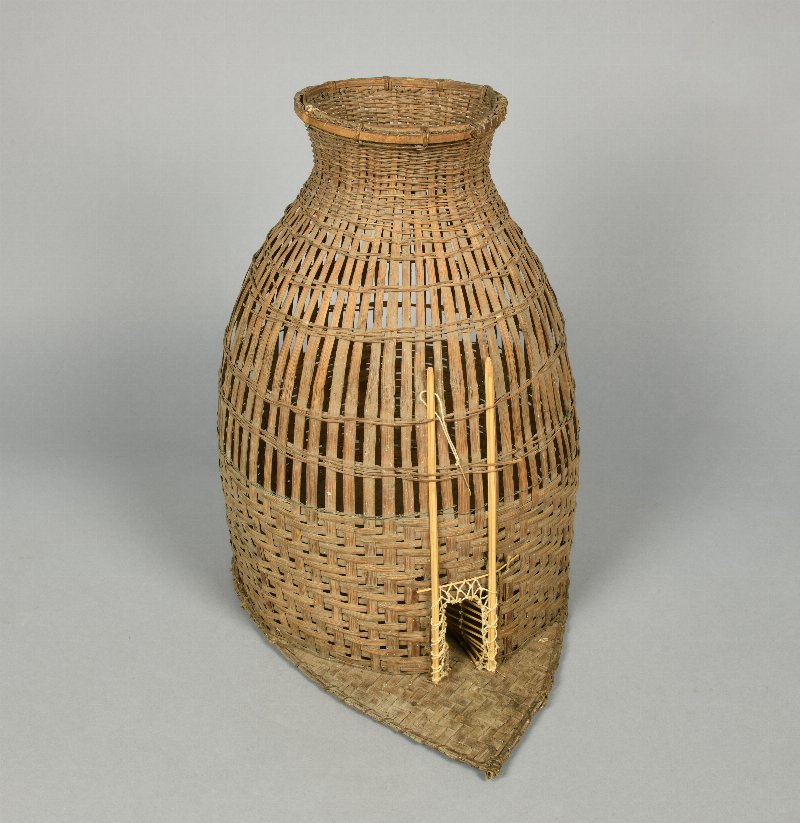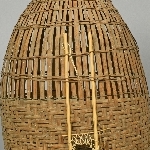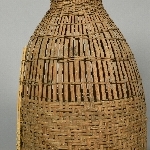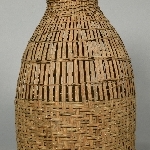Fish Trap
82-7-200
From: Thailand | Udon Thani | Ban Pu Lu
Curatorial Section: Asian
| Native Name | Tum Pla Khao | ตุ้มปลาขาว |
| Object Number | 82-7-200 |
| Current Location | Collections Storage |
| Culture | Thai | Isaan |
| Provenience | Thailand | Udon Thani | Ban Pu Lu |
| Site Name | Ban Pu Lu | บ้านปูลู |
| Date Made | 1900-1981 |
| Section | Asian |
| Materials | Fiber | Nylon | Cotton |
| Subject | Fishing Equipment |
| Description | This fish trap is made principally of flexible woven strips of bamboo, possibly Bambusa vulgaris, a bamboo variety that is often cultivated in villages of the region and is used for many local crafts. A fiber made from a wild climber Parameria laevigata (Juss.) Moldenke is cross woven with bamboo strips in the upper portion of the trap in such a way as to allow water to flow through the trap. Cotton string, possibly from locally grown cotton, is used with short bamboo sticks to create the flexible trap gateway that allows the fish to enter near the bottom of the trap but prevents the fish from leaving. The bamboo sticks in the gateway slot attached to the web of strings are designed to quiver in the water flow, which is known to attract the fish. Only one foreign item, plastic/nylon twine, was used at the top of the lower section where the horizontal bamboo strips cease. Typically leaves below the narrow neck or a half coconut shell fastened at the top could have closed that exit for captured fish. The trap is designed to catch the species of fish locally called “plaa khaaw” (ตุ้มปลาขาว) Henicorhynchus siamensis, or Siamese Mud Carp. These fish typically reach eight or more inches in length and can be caught especially after they have migrated upstream to spawn in the greater Mekong Basin, a spawning journey that peaks during the later part of the rainy season in October and November. The fish congregate and like to burrow in mud, a behavior that the trap’s low entryway is designed to take advantage of. Villagers place the trap in gentle river and lake edge waters in the early morning, during the rice harvest season. The trap is put in water about one meter deep, where it can be staked in with a pole that marks the spot. The point on the base faces upstream so that the flow of the water encourages the fish to find the trap door. Baited with bran, the trap can be emptied both at noon and evening by lifting the trap and pouring out the fish through the neck and into a container. The fish can be grilled, but this species is also commonly used for fermented fish, an important source of protein throughout the year and used in many local dishes. The owner was a Mr. Luea (เหลือ). |
| Height | 40 cm |
| Length | 39 cm |
| Width | 28 cm |
| Outside Diameter | 14 cm |
| Credit Line | Thai-Lao Ethnographic Expedition, Joyce C. White, 1981 |
| Other Number | 111 - Field Number |
Report problems and issues to digitalmedia@pennmuseum.org.





